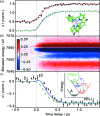The X-ray Pump-Probe instrument at the Linac Coherent Light Source
- PMID: 25931060
- PMCID: PMC4416667
- DOI: 10.1107/S1600577515005135
The X-ray Pump-Probe instrument at the Linac Coherent Light Source
Abstract
The X-ray Pump-Probe instrument achieves femtosecond time-resolution with hard X-ray methods using a free-electron laser source. It covers a photon energy range of 4-24 keV. A femtosecond optical laser system is available across a broad spectrum of wavelengths for generating transient states of matter. The instrument is designed to emphasize versatility and the scientific goals encompass ultrafast physical, chemical and biological processes involved in the transformation of matter and transfer of energy at the atomic scale.
Keywords: FEL; X-ray; pump–probe; time-resolved.
Figures



References
-
- Amann, J. et al. (2012). Nat. Photon. 6, 693–698.
-
- Beaud, P. et al. (2014). Nat. Mater. 13, 923–927. - PubMed
-
- Bionta, M. R., Lemke, H. T., Cryan, J. P., Glownia, J. M., Bostedt, C., Cammarata, M., Castagna, J.-C., Ding, Y., Fritz, D. M., Fry, A. R., Krzywinski, J., Messerschmidt, M., Schorb, S., Swiggers, M. L. & Coffee, R. N. (2011). Opt. Express, 19, 21855–21865. - PubMed
Publication types
MeSH terms
LinkOut - more resources
Full Text Sources
Medical

